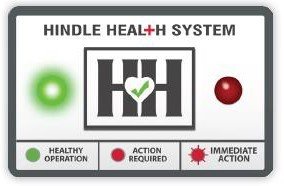The [HH] button initiates the EPIC Console’s Hindle Health System (HHS). The user is guided through a series of tests that verify that the console and connected equipment are working properly. The HHS monitors the internal environment and system components and will alert you when attention is required via the HHS status LEDs – that appear on the door of the EPIC Series Battery Cabinet and on the EPIC Controller. This information can be reported via Modbus or DNP protocols using an RS-485 serial port or Ethernet.

- The GREEN indicating LED lets the user know, from a distance, the system is operating properly and maintaining system reliability.
- The STEADY RED indicator lets the user know there is an alarm or issue that requires action, but the console is still maintaining system reliability.
- A BLINKING RED indicator lets the user know there is an alarm that requires immediate action because system reliability is at risk.
Test results are logged with a time and date stamp, as discussed in Section 9, Event Logs.
The HHS can monitor many parameters. Most will be standard console features, but with the integration of an AT Series or ATevo battery charger more can be added. Any equipment within the EPIC Console system, including but not limited to: battery chargers, converters, heaters, air conditioners, smoke alarms, hydrogen detectors, fans, door alarms, and voltage sensing equipment can be monitored. Any device able to communicate a common alarm can be integrated into EPIC’s HHS.
A complete description of the tests performed by the Hindle Health System can be found in Section 8.


